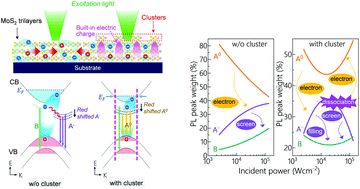Spatially isolated neutral excitons via clusters on trilayer MoS2†
Abstract
In spite of having a large exciton binding energy, two-dimensional (2D) transition metal dichalcogenides (TMDs) are limited as light-emitting materials because the spectral weight of neutral excitons decreases exponentially with increasing the excitation density. That is, neutral excitons easily transfer to trions, and exciton–exciton annihilation (EEA) occurs due to the strengthening of exciton kinetic energy in the layered structure. In here, we come up with an isolated neutral exciton system, maintaining its high spectral weight when the carrier density increased, which is achieved via MoS2 clusters on a MoS2 trilayer directly synthesized by metal–organic chemical vapor deposition (MOCVD). While increasing the excitation density, trions are decomposed by spatial confinement at the saturation level of its full width at half maximum (FWHM), and simultaneously the spectral weight of neutral excitons restarts to increase. Furthermore, we reveal the causality relationship between trions and B excitons, providing a keen insight into organic interactions among radiative recombination processes in 2D TMDs.



 Please wait while we load your content...
Please wait while we load your content...